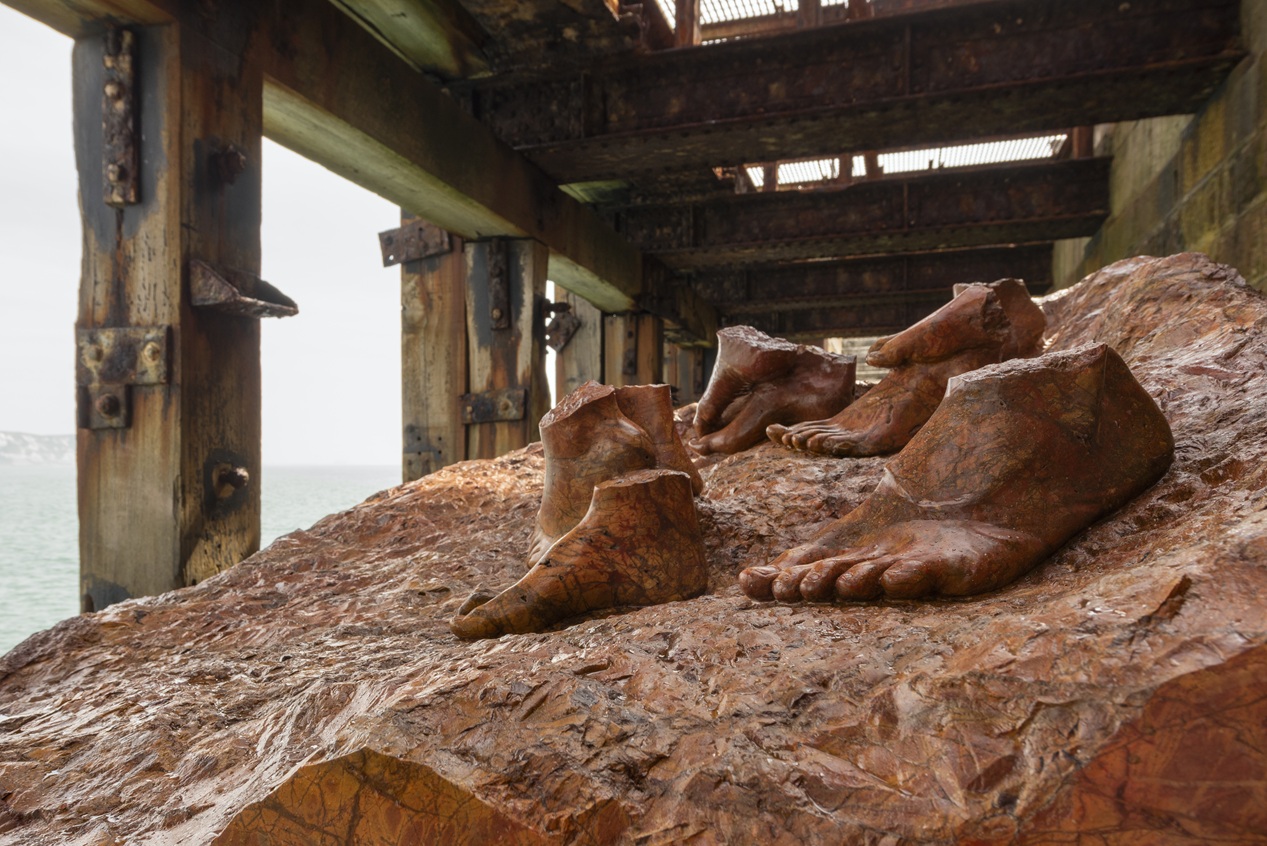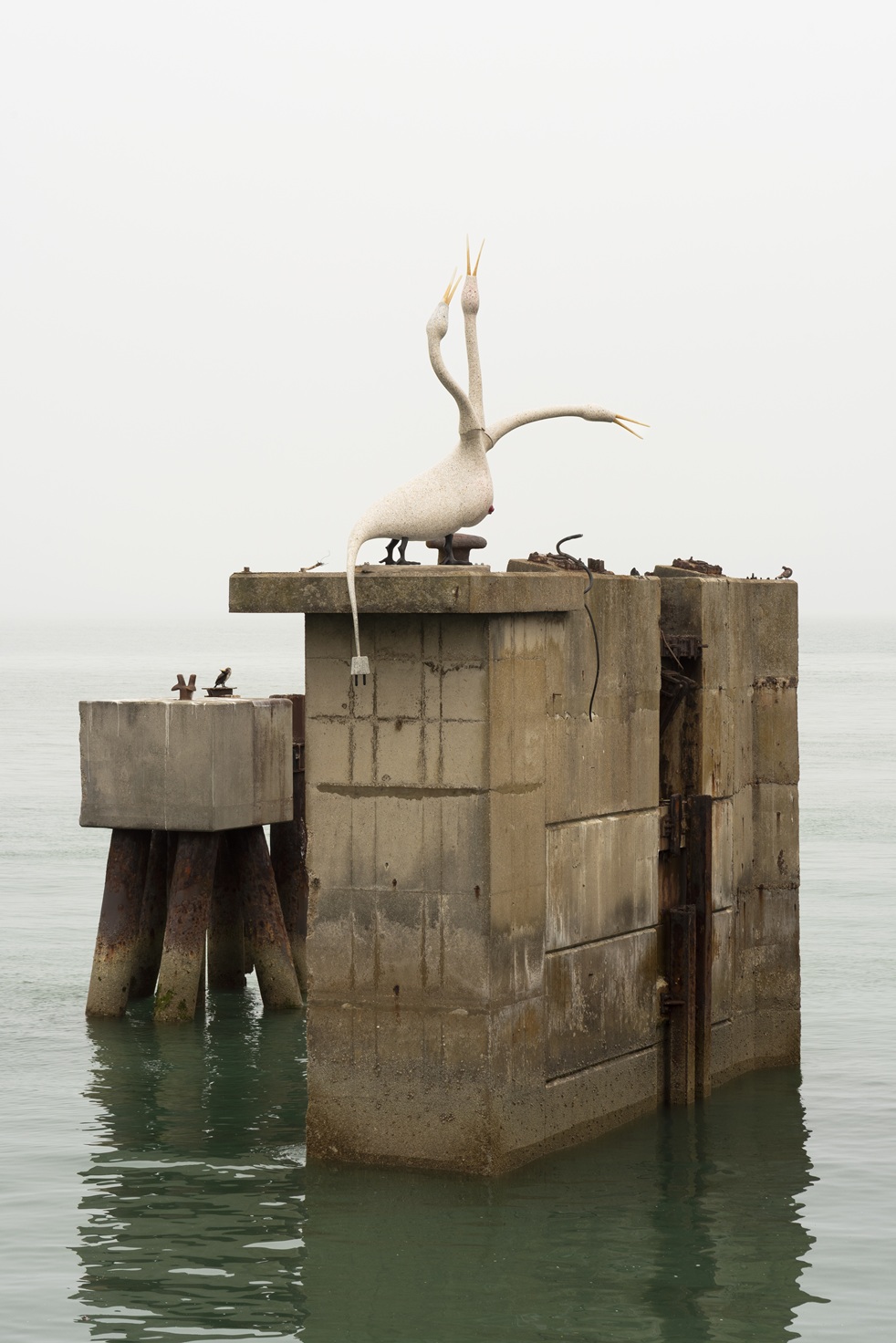Folkestone Triennial 2025 - landscape, seascape, art lovers' escape | reviews, news & interviews
Folkestone Triennial 2025 - landscape, seascape, art lovers' escape
Folkestone Triennial 2025 - landscape, seascape, art lovers' escape
Locally rooted festival brings home many but not all global concerns

A rare cloud form envelopes the headland and to the east and the west Folkestone is cut off from the known world. This mist shortens the visual range, drawing attention to the chalky soil, the sea gorse and the looping swifts. It also softly frames 18 site specific works of contemporary art that work in sympathy with this historic settlement. Folkestone is, as the Triennial shows, rich in local inspiration.
One emblematic work is Oceans Tree of Life (all works 2025) by Jennifer Tee, installed above a coastal landslide known as the Warren (main picture). It is adjacent to a dig site where on this overcast day, an industrious team of archaeologists go about their business. As if to cross-pollinate human ruins with marine life, the Dutch artist has built a maze of hand-fired bricks, which from the elevated north end of the piece can be seen to resemble a marine plant. Inlaid in rust-coloured paving are traces of fossil and also bladderwrack engraved or moulded with sea glass. Tree offers a straightforward meditation on the source of all life on earth, and a celebration of childhood rock-pool finds in places such as this.
Further ahead, connecting deep past to Neolithic times, is Urn Field by Sara Trillo. Here the terrain becomes overgrown and brambly, but along a trail of flattened grasses, are a series of sculptures inspired by fragments of funerary pottery found here in the town’s museum. Trillo’s sand-coloured works surface around every overgrown corner, and each one laced with local plant life, chosen for health-giving properties. They are magnified to a scale at which the detritus looks timeless: broken open, they release the Neolithic dead from their containment of many millennia. Wild hedgerows tremble with the activity of sparrows and in the shelter of a World War One lookout post, the visitor is invited to consider Love (Warbler Remix) by Hanna Tuulikki. This compares the song of a marsh warbler to the music of a fictional “love warbler”; both birds are mimics and sonic magpies. This is a richly layered piece, strong in both research and imagination, which celebrates migration and subverts the region’s many coastal defences with a radio broadcast from the sound mirrors at Dungeness.
Wild hedgerows tremble with the activity of sparrows and in the shelter of a World War One lookout post, the visitor is invited to consider Love (Warbler Remix) by Hanna Tuulikki. This compares the song of a marsh warbler to the music of a fictional “love warbler”; both birds are mimics and sonic magpies. This is a richly layered piece, strong in both research and imagination, which celebrates migration and subverts the region’s many coastal defences with a radio broadcast from the sound mirrors at Dungeness.
After navigating the clifftops, a day tripper will most likely gravitate to the harbour, where another sound work awaits. Ode to the Channel, by Emeka Ogboh, may seduce you into settling down on a some waterside steps and listening to a capella song and the slap of waves until the tide takes your shoes. Ogboh has worked with local composer Rachel Gerrard and a small all-female choir named the Sirens in order to give voice to this contested waterway.
This is one of three liminal works that connect the Kent coast to northern France to offer a welcome that is sadly lacking from our news headlines. Dorothy Cross has even imported stone from the troubled land of Syria. Red Erratic is inspired by a block of beautiful, sheer, veiny marble that now rests at the base of the harbour wall (pictured above). Sculpted into the topside of this block are a set of more than half a dozen severed feet that, as the tidal water rises, appear to float. The veins of the marble look physiological; the realism of the feet evokes a Renaissance interest in anatomy.
 In both these works, the harbour infrastructure provides a compelling element. And in a town that is sometimes mired in (stirred-up) controversy about immigration, we remember that it is here that troops and holidaymakers would leave, in the other direction, for a continent that is just 30 miles away. A ferry stanchion forms a plinth for a third architectonic work, which is a tenderly monstrous mystical beast created by Laure Prouvost. Here a Cerebus-headed mother bird, with Type C plug for tail and three glass beaks looks across to a youngster. As its title suggests, Above Front Tears, Oui Connect is as poetic as it is enigmatic (pictured left).
In both these works, the harbour infrastructure provides a compelling element. And in a town that is sometimes mired in (stirred-up) controversy about immigration, we remember that it is here that troops and holidaymakers would leave, in the other direction, for a continent that is just 30 miles away. A ferry stanchion forms a plinth for a third architectonic work, which is a tenderly monstrous mystical beast created by Laure Prouvost. Here a Cerebus-headed mother bird, with Type C plug for tail and three glass beaks looks across to a youngster. As its title suggests, Above Front Tears, Oui Connect is as poetic as it is enigmatic (pictured left).
It couldn’t be more different from the pragmatic, research-led project here by Cooking Sections. The artist duo has assembled an archive of material about the poor state of Southern Water and badged it all with governmental gravitas by establishing a quayside Ministry of Sewers, where the public are invited to share horror stories about Kent pollution which local activists will compile for the attention of sympathetic lawyers. It walks a deft line between performativity and seriousness.
Another research-heavy work is to be found at a suburban Martello tower which dates back to the Napoleonic wars. Within its rounded confines are two beautifully crafted, semi-circular tables which showcase 197 amulets which may or may not protect us from the times to come. Each of these is based on an actual museum artefact from ancient civilisation[2] s across the world. They have been 3D scanned, printed, moulded and combined with materials that represent zones of planetary annihilation or conflict. Afterlife by Katie Paterson is a tremendously intelligent and well-thought-out piece (pictured below). Fusing technology with simian consciousness, Irish artist john gerrard take the viewer into a virtual world, digitally mapped onto a monolithic screen on disused rail tacks. His film is a slow panning CGI shot around a burning forest tree line in which a spider monkey contemplates its own face on a smartphone. Ghost Feed has been generated by a gaming engine called Unreal and represents a real time live yet imaginary world from Brazil where trees are cut down to create soya for cattle feed in the global north.
Fusing technology with simian consciousness, Irish artist john gerrard take the viewer into a virtual world, digitally mapped onto a monolithic screen on disused rail tacks. His film is a slow panning CGI shot around a burning forest tree line in which a spider monkey contemplates its own face on a smartphone. Ghost Feed has been generated by a gaming engine called Unreal and represents a real time live yet imaginary world from Brazil where trees are cut down to create soya for cattle feed in the global north.
It is pertinent, and indeed scary. Like the works by Cooking Sections and Katie Paterson it warns both townsfolk and tourist that the world is getting worse. But if the worst of this world right now is to be found in Washington and Gaza, these are emergency situations with no direct reference at Folkestone Triennial 2025. Instead the new public works relate to the relative comforts of ongoing climate change, pollution near and far, geological change and deep time.
The rain that was earlier predicted did not materialise, and by late afternoon many have chosen to splash their way across the sands to swim in the grey sea. Here is everything you could hope for from a homegrown day out, together with a public sculpture programme of a calibre you won’t find anywhere else in the UK. Combining art with amenities, Folkestone offers all the ingredients of a weekend getaway. But when the sun returns to burn off the mist, the way this Triennial is so securely grounded in place, may just seem a little untethered from the present moment.
rating
Explore topics
Share this article
The future of Arts Journalism
You can stop theartsdesk.com closing!
We urgently need financing to survive. Our fundraising drive has thus far raised £49,000 but we need to reach £100,000 or we will be forced to close. Please contribute here: https://gofund.me/c3f6033d
And if you can forward this information to anyone who might assist, we’d be grateful.

Subscribe to theartsdesk.com
Thank you for continuing to read our work on theartsdesk.com. For unlimited access to every article in its entirety, including our archive of more than 15,000 pieces, we're asking for £5 per month or £40 per year. We feel it's a very good deal, and hope you do too.
To take a subscription now simply click here.
And if you're looking for that extra gift for a friend or family member, why not treat them to a theartsdesk.com gift subscription?
more Visual arts
 'We are bowled over!' Thank you for your messages of love and support
Much-appreciated words of commendation from readers and the cultural community
'We are bowled over!' Thank you for your messages of love and support
Much-appreciated words of commendation from readers and the cultural community
 Folkestone Triennial 2025 - landscape, seascape, art lovers' escape
Locally rooted festival brings home many but not all global concerns
Folkestone Triennial 2025 - landscape, seascape, art lovers' escape
Locally rooted festival brings home many but not all global concerns
 Sir Brian Clarke (1953-2025) - a personal tribute
Remembering an artist with a gift for the transcendent
Sir Brian Clarke (1953-2025) - a personal tribute
Remembering an artist with a gift for the transcendent
 Emily Kam Kngwarray, Tate Modern review - glimpses of another world
Pictures that are an affirmation of belonging
Emily Kam Kngwarray, Tate Modern review - glimpses of another world
Pictures that are an affirmation of belonging
 Kiefer / Van Gogh, Royal Academy review - a pairing of opposites
Small scale intensity meets large scale melodrama
Kiefer / Van Gogh, Royal Academy review - a pairing of opposites
Small scale intensity meets large scale melodrama
 Jenny Saville: The Anatomy of Painting, National Portrait Gallery review - a protégé losing her way
A brilliant painter in search of a worthwhile subject
Jenny Saville: The Anatomy of Painting, National Portrait Gallery review - a protégé losing her way
A brilliant painter in search of a worthwhile subject
 Abstract Erotic, Courtauld Gallery review - sculpture that is sensuous, funny and subversive
Testing the boundaries of good taste, and winning
Abstract Erotic, Courtauld Gallery review - sculpture that is sensuous, funny and subversive
Testing the boundaries of good taste, and winning
 Edward Burra, Tate Britain review - watercolour made mainstream
Social satire with a nasty bite
Edward Burra, Tate Britain review - watercolour made mainstream
Social satire with a nasty bite
 Ithell Colquhoun, Tate Britain review - revelations of a weird and wonderful world
Emanations from the unconscious
Ithell Colquhoun, Tate Britain review - revelations of a weird and wonderful world
Emanations from the unconscious
 Rachel Jones: Gated Canyons, Dulwich Picture Gallery review - teeth with a real bite
Mouths have never looked so good
Rachel Jones: Gated Canyons, Dulwich Picture Gallery review - teeth with a real bite
Mouths have never looked so good
 Yoshitomo Nara, Hayward Gallery review - sickeningly cute kids
How to make millions out of kitsch
Yoshitomo Nara, Hayward Gallery review - sickeningly cute kids
How to make millions out of kitsch
 Hamad Butt: Apprehensions, Whitechapel Gallery review - cool, calm and potentially lethal
The YBA who didn’t have time to become a household name
Hamad Butt: Apprehensions, Whitechapel Gallery review - cool, calm and potentially lethal
The YBA who didn’t have time to become a household name

Add comment